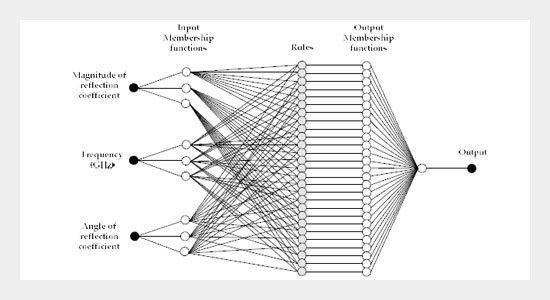Ojo O. Adedayoa*, M. M. Isaa, A. Che Soha, and Z. Abbasb aDepartment of Electrical and Electronic Engineering, Faculty of Engineering, University Putra Malaysia
bDepartment of Physics, Faculty of Science, University Putra Malaysia
Download Citation:
|
Download PDF
Accurate dielectric models are required for proper sensing and characterization of materials especially for the purpose of quality control. In this work, a multi-Adaptive Neuro-Fuzzy Inference System (ANFIS) was designed to model the complex permittivity of the mesocarps of oil palm fruitlets within the frequency range of 2-4GHz. The system consists of two ANFIS models with same sets of inputs; one ANFIS model for the dielectric constant and the other for the loss factor. Training data were obtained from laboratory microwave measurements with the aid of Vector Network Analyzer (VNA) and used for the ANFIS model. The evaluation of the performance of the model confirms the suitability of the multi-ANFIS model for rapid and accurate determination of the dielectric properties of the fruitlets.ABSTRACT
Keywords:
ANFIS; dielectric properties; oil palm fruitlets; sensing.
Share this article with your colleagues
[1] Trabelsi, S. and Nelson, S. O. 2006. Nondestructive sensing of bulk density and moisture content in shelled peanuts from microwave permittivity measurements. Food Control, 17(4): 304-311.REFERENCES
[2] Sosa-Morales, M. E., Valerio-Junco, L., López-Malo, A., and García, H. S. 2010. Dielectric properties of foods: reported data in the 21st century and their potential applications. LWT-Food Science and Technology, 43(8): 1169-1179.
[3] Bohleber, P., Wagner, N., and Eisen, O. 2012. Permittivity of ice at radio frequencies: part I. coaxial transmission line cell. Cold Regions Science and Technology, 82: 56-67.
[4] Van der Vossen, H. A. M. 1974. Towards more efficient selection for oil yield in the oil palm. Centre for Agricultural Publishing and Documentation, 57-58.
[5] You, K. Y., Abbas, Z., and Khalid, K. 2010. Application of microwave moisture sensor for determination of oil palm fruit ripeness. Measurement Science Review, 10(1): 7-14.
[6] Terzic, E., Nagarajah, R., and Alamgir, M. 2011. A neural network approach to fluid quantity measurement in dynamic environments. Mechatronics, 21(1): 145-155.
[7] Erzin, Y., Rao, B. H., Patel, A., Gumaste, S. D., and Singh, D. N. 2010. Artificial neural network models for predicting electrical resistivity of soils from their thermal resistivity. International Journal of Thermal Sciences, 49(1): 118-130.
[8] Neshat, N., Mahlooji, H., and Kazemi, A. 2011. An enhanced neural network model for predictive control of granule quality characteristics. Scientia Iranica, 18(3): 722-730.
[9] Brás, S., Gouveia, S., Ribeiro, L., Ferreira, D. A., Antunes, L. and Nunes, C. S. 2013. Research in veterinary science fuzzy logic model to describe anesthetic effect and muscular influence on EEG cerebral state index. Research in Veterinary Science, 94: 735-742.
[10] Franco-Lara, E. and Weuster-Botz, D. 2007. Application of fuzzy-logic models for metabolic control analysis. Journal of Theoretical Biology, 245(3): 391-9.
[11] Hashmi, K., Graham, I., Mills, B., and Hashmi, M. S. 2003. Adjustment approach for fuzzy logic model based selection of non-overlapping machining data in the turning operation. Journal of Materials Processing Technology, 142(1): 152-162.
[12] Krajnc, D., Mele, M., and Glavič, P. 2007. Fuzzy logic model for the performance benchmarking of sugar plants by considering best available techniques. Resources, Conservation and Recycling, 52(2): 314-330.
[13] Silva, R. P. M., Delbem, A. C. B., and Coury, D. V. 2013. Genetic algorithms applied to phasor estimation and frequency tracking in PMU development. International Journal of Electrical Power & Energy Systems, 44: 921-929.
[14] Daneshfar, F. and Bevrani, H. 2012. Multiobjective design of load frequency control using genetic algorithms. International Journal of Electrical Power & Energy Systems, 42: 257-263.
[15] Mitra, A., Kundu, D., and Agrawal, G. 2006. Frequency estimation of undamped exponential signals using genetic algorithms. Computational Statistics & Data Analysis, 51(3): 1965-1985.
[16] Xu, X. and Wang, S. 2007. Optimal simplified thermal models of building envelope based on frequency domain regression using genetic algorithm. Energy and Buildings, 39(5): 525-536.
[17] Vakil-Baghmisheh, M. T., Peimani, M., Sadeghi, M. H., and Ettefagh, M. M. 2008. Crack detection in beam-like structures using genetic algorithms. Applied Soft Computing, 8(2): 1150-1160.
[18] Naderloo, L., Alimardani, R., Omid, M., Sarmadian, F., Javadikia, P., Torabi, M. Y., and Alimardani, F. 2012. Application of ANFIS to predict crop yield based on different energy inputs. Measurement, 45(6): 1406-1413.
[19] Nazari, A. and Khalaj, G. 2012. “Prediction Compressive Strength of Lightweight Geopolymers by ANFIS”. Ceramics International.
[20] Jiang, H. M., Kwong, C. K., Ip, W. H., and Wong, T. C. 2012. Modeling customer satisfaction for new product development using a PSO-based ANFIS approach. Applied Soft Computing, 12(2): 726-734.
[21] İnal, M. 2008. Determination of dielectric properties of insulator materials by means of ANFIS: a comparative study. Journal of Materials Processing Technology, 195(1-3): 34-43.
[22] Daldaban, F., Ustkoyuncu, N., and Guney, K. 2006. Phase inductance estimation for switched reluctance motor using adaptive neuro-fuzzy inference system. Energy Conversion and Management, 47(5): 485-493.
[23] İnal, M. 2008. Determination of dielectric properties of insulator materials by means of ANFIS: a comparative study. Journal of Materials Processing Technology, 195(1-3): 34-43.
ARTICLE INFORMATION
Received:
2013-05-08
Revised:
2013-08-20
Accepted:
2013-10-08
Available Online:
2014-03-01
Adedayo, O.O., Isa, M.M., Soh, A.C., Abbas, Z. 2014. Multi-Adaptive Neuro-Fuzzy inference system for dielectric properties of oil palm fruitlets. International Journal of Applied Science and Engineering, 12, 1–8. https://doi.org/10.6703/IJASE.2014.12(1).1
Cite this article:






